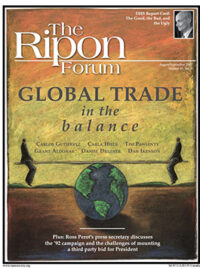With the 2008 election still more than a year away, the campaigns are already in full swing with the usual television advertisements, candidate debates, and endless commentary. But polling data indicates that thus far, voter awareness of the policy issues and the solutions being offered is minimal. As of last month, for instance, 60 percent of the public could not identify the presidential candidate who best represented their views on health care.
Limited public awareness of the candidates’ positions is symptomatic of a broader civic malaise in this country. In a recent four-nation study of citizens’ ability to recognize international and domestic news stories, Americans ranked dead last. While 37 percent of Americans knew that the Kyoto Accords concerned climate change, the comparable figure in Britain, Denmark and Finland was over 70 percent. In the case of Darfur, 47 percent of the Americans correctly identified the country in question compared with more than 60 percent of the Europeans.

This substantial information gap on matters of public affairs disappeared almost entirely, however, on matters of pop culture, entertainment or sports. Here, Americans were just as well informed as Europeans. The striking disparity in civic information between Europeans and Americans is attributable, in part, to differences in media systems. Although it is widely accepted as desirable that the media in a democratic society deliver a variety of perspectives on social issues, American news organizations have generally failed to live up to these obligations.
One reason is a simple failure of public policy: we are the only democracy that does not require commercial broadcasters to provide at least a minimal level of public affairs programming, and we have never nurtured a publicly subsidized alternative to commercial television. In comparison with the public broadcasters of Europe, PBS is starved of public funding. Unable to act as a full service news organization, PBS attracts a 2 percent market share; in Europe, public broadcasters average around 30 percent. At the same time, news organizations in our deregulated market depend on advertising revenues and hence audience size. A documentary on the conflict in Darfur is unlikely to generate high ratings, while news of Paris Hilton’s histrionics is apparently riveting. Infotainment now replaces news.
The absence of a viable public broadcaster and the highly competitive media market mean that most Americans rarely encounter in depth programming about current issues. What news they do encounter is heavily domesticated (most overseas bureaus have long since been closed) and presented in a manner designed to tantalize rather than inform.
The media seem to assume that the candidates’ positions on the issues are “old” news, hardly worthy of development.
In the case of campaigns, somewhat paradoxically, the independence so valued by journalists exacts a further toll on news coverage. Journalistic attention to the “horse race” aspects of the campaign provides an “independent” role for the media, is fairly cost effective, and does attract the attention of the public. Hence the news is heavily laden with information about fund-raising, the candidates’ standing in the polls, speculations about campaign strategy, and professional analysis of the candidates’ actions. Far less attention is devoted to basic coverage of issue positions (including encouraging candidates to articulate and defend those positions). The media seem to assume that the candidates’ positions on the issues are “old” news, hardly worthy of development.
Of course, “debates” are televised, but these events tend to take on the format of heavily scripted joint appearances in which genuine engagement on the issues is limited as each candidate pursues his or her own pet themes. Not surprising, in this election cycle, the candidates have already publicly complained about “debate fatigue” – an experience probably shared by the attentive public.
Is technology the answer to the problem of superficial news and voter apathy? The recent presidential debate sponsored by CNN and YouTube won praise for including “turned off” Americans — especially younger voters — in the political process. But will this kind of new media involvement lead to greater political awareness as well? Probably not. Indeed, there are several reasons to doubt that more media choices will lead to better informed voters. Political junkies will take full advantage of the Internet, but most of the public prefers E-Bay or ESPN to Washingtonpost.com.
Moreover, technology is likely to segment the audience for news — like consumers of goods and services, people will seek out their “preferred” providers and ignore all others. The preferred providers might be sources that one anticipates agreeing with (e.g. Republicans and Fox News) or sources that share the voter’s concern about particular issues (e.g. gun owners and the NRA). As news delivery/consumption is increasingly customized, it becomes impossible to assure exposure to differing viewpoints.
What can be done to increase substantive coverage of campaigns? An obvious first step is to require that television networks and stations provide free time for candidates in the weeks preceding the election. Free time is a fixture in all European democracies, but the U.S. broadcasting industry has successfully blocked adoption of similar measures in the US. Given the huge amounts of revenue station owners generate from political advertising (over $2 billion in 2006), it is difficult to understand how they can reasonably object to providing small blocks of time for national and local candidates. (Many congressional races actually receive no televised coverage at all today.)
It is time for Congress to insist on a free time requirement for federal and state candidates; as owners of the airwaves, the public is entitled to nothing less.
Shanto Iyengar is Professor of Political Science and Communications at Stanford University. His most recent book is Media Politics: A Citizen’s Guide (W. W. Norton, 2007).




